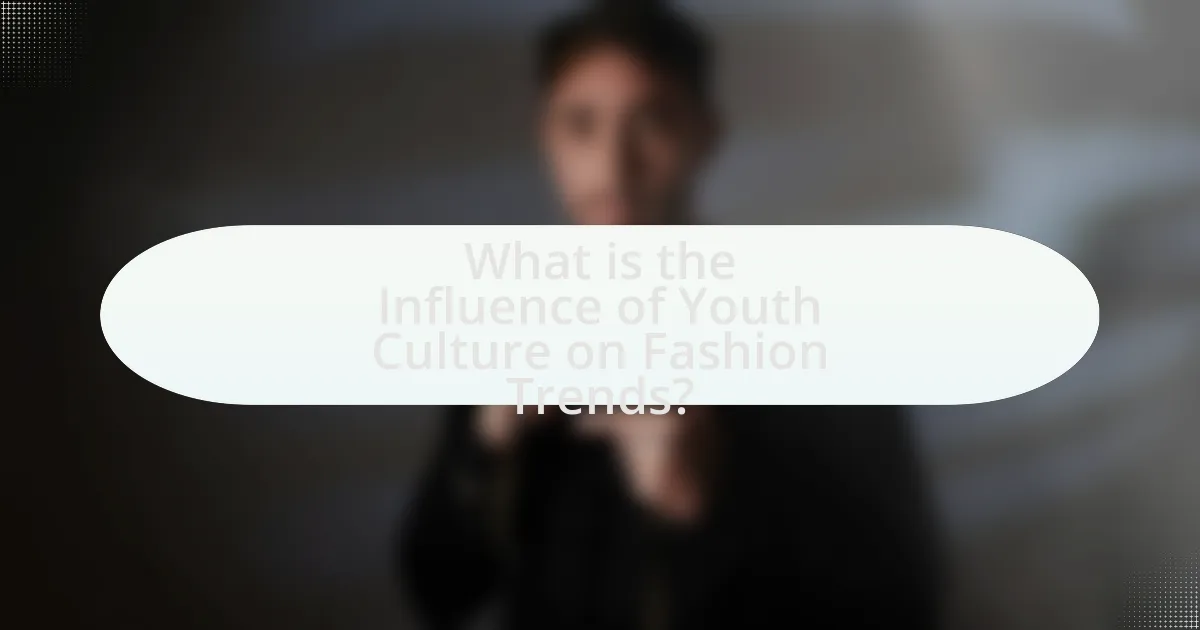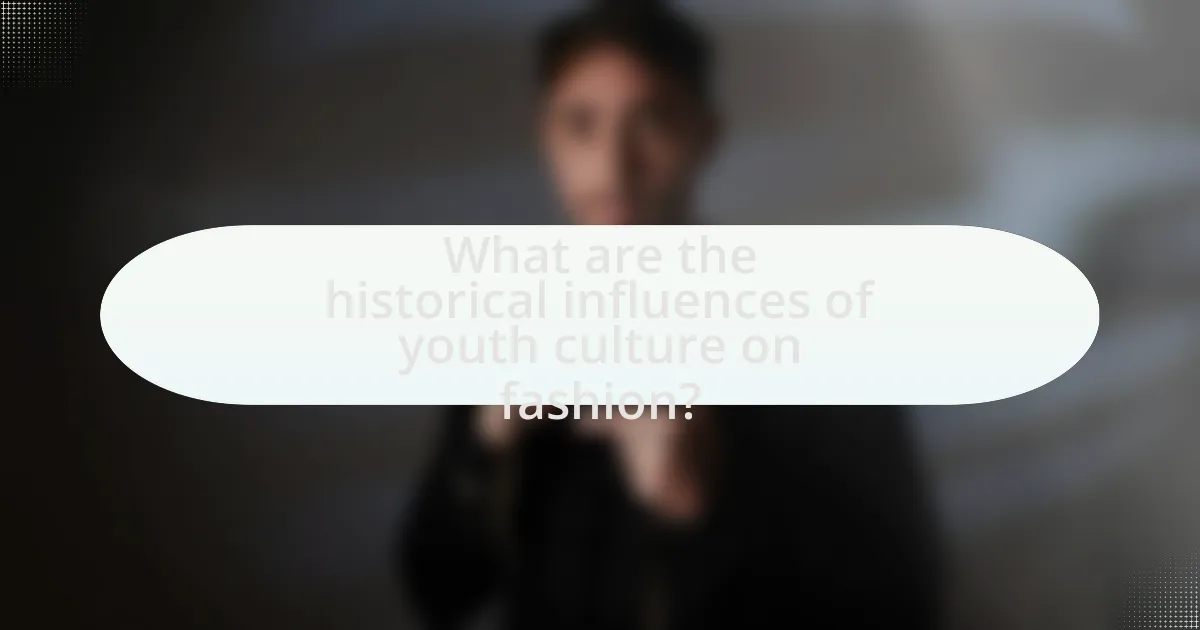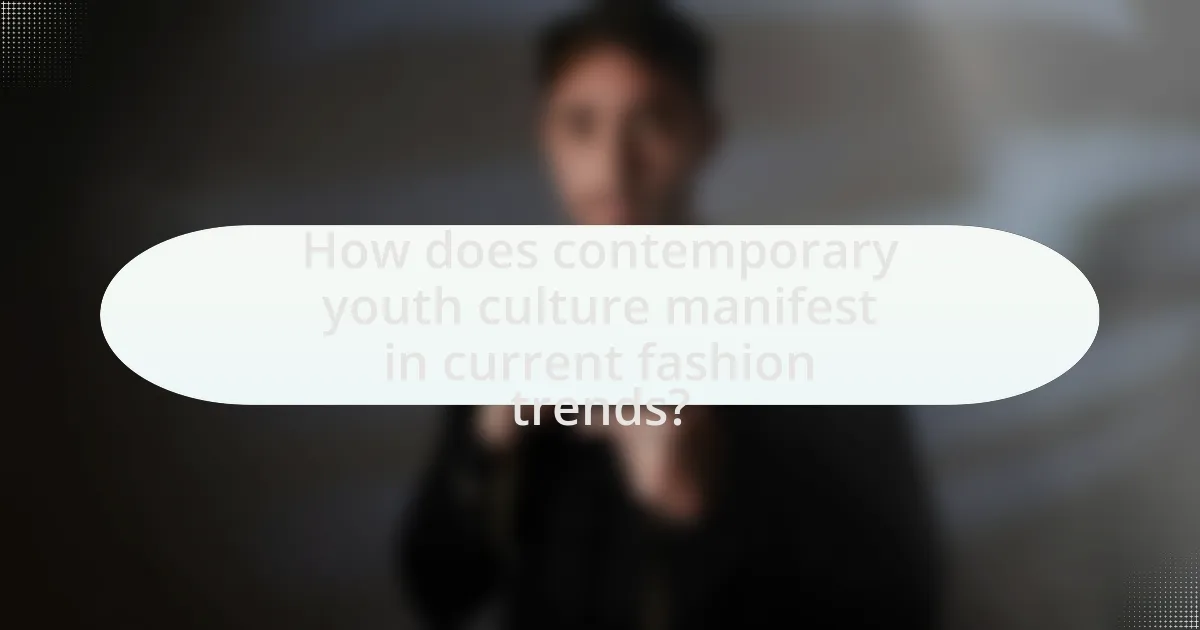The article examines the significant influence of youth culture on fashion trends, highlighting how this demographic drives innovation and shapes consumer preferences through social media, music, and subcultures. It discusses the key elements of youth culture, such as peer influence and identity expression, and their impact on fashion choices, including the rise of streetwear and sustainable practices. Additionally, the article explores historical influences of youth movements on contemporary fashion, the role of influencers, and the importance of cultural diversity and globalization in shaping current trends. It emphasizes the need for brands to align with the values of younger consumers, particularly regarding sustainability and ethical practices.

What is the Influence of Youth Culture on Fashion Trends?
Youth culture significantly influences fashion trends by driving innovation and shaping consumer preferences. This demographic, often characterized by its distinct values, interests, and social behaviors, actively engages with fashion through social media platforms, music, and subcultures. For instance, the rise of streetwear, which blends casual styles with high fashion, can be traced back to youth movements in urban areas, particularly among skateboarders and hip-hop communities. According to a report by McKinsey & Company, Gen Z consumers are more likely to prioritize sustainability and inclusivity in their fashion choices, further impacting brand strategies and market offerings. This generational shift underscores the power of youth culture in dictating not only what is trendy but also the ethical considerations surrounding fashion consumption.
How does youth culture shape fashion choices?
Youth culture significantly shapes fashion choices by promoting trends that reflect its values, interests, and social dynamics. For instance, the rise of streetwear in the 1990s, influenced by hip-hop culture and skateboarding, led to widespread adoption of casual, comfortable clothing among young people. This trend was further amplified by social media platforms, where youth showcase their styles, creating a feedback loop that encourages rapid trend cycles. Research indicates that 70% of young consumers are influenced by peers and social media when making fashion decisions, highlighting the direct impact of youth culture on contemporary fashion.
What are the key elements of youth culture that impact fashion?
The key elements of youth culture that impact fashion include music, social media, peer influence, and identity expression. Music genres, such as hip-hop and punk, often dictate fashion trends by inspiring styles that resonate with youth subcultures. Social media platforms like Instagram and TikTok amplify these trends, allowing for rapid dissemination and adaptation of fashion styles among young people. Peer influence plays a crucial role, as youth often look to their friends and social circles for validation of their fashion choices. Additionally, identity expression drives young individuals to adopt styles that reflect their personal beliefs, values, and affiliations, leading to diverse and evolving fashion trends. These elements collectively shape the fashion landscape, making youth culture a significant force in the industry.
How do social media platforms influence youth fashion trends?
Social media platforms significantly influence youth fashion trends by providing a space for rapid dissemination of styles and trends among young users. Platforms like Instagram, TikTok, and Pinterest allow influencers and peers to showcase their outfits, creating a visual culture that encourages imitation and trend adoption. According to a 2021 study by the Pew Research Center, 72% of teens reported that social media influences their fashion choices, highlighting the platforms’ role in shaping preferences. The immediacy of social media also fosters a sense of urgency around trends, as styles can go viral overnight, prompting youth to adopt new looks quickly.
Why is youth culture significant in the fashion industry?
Youth culture is significant in the fashion industry because it drives trends and shapes consumer behavior. The preferences and values of young people often dictate what styles become popular, as they are typically more open to experimentation and change. For instance, the rise of streetwear in the late 2010s, characterized by brands like Supreme and Off-White, was largely fueled by youth culture’s embrace of casual, urban aesthetics. Additionally, according to a 2021 report by McKinsey & Company, Gen Z consumers are projected to account for 40% of global apparel spending by 2025, highlighting their influence on market dynamics. This demographic’s engagement with social media platforms further amplifies their impact, as trends can spread rapidly through channels like TikTok and Instagram, making youth culture a pivotal force in the fashion industry.
What role do youth demographics play in fashion marketing?
Youth demographics significantly influence fashion marketing by shaping trends, preferences, and purchasing behaviors. Brands target younger consumers, typically aged 18 to 34, as they are trendsetters and early adopters, driving the demand for innovative styles and sustainable practices. According to a 2021 McKinsey report, 70% of Gen Z consumers prefer brands that align with their values, such as inclusivity and environmental responsibility. This demographic’s strong presence on social media platforms further amplifies their impact, as they engage with brands and share their fashion choices, creating viral trends. Thus, understanding youth demographics is crucial for fashion marketers to effectively connect with this influential consumer group.
How do youth-led movements affect fashion brands?
Youth-led movements significantly influence fashion brands by driving demand for ethical practices and social responsibility. These movements, such as climate activism and social justice campaigns, compel brands to adopt sustainable materials and transparent supply chains to align with the values of younger consumers. For instance, the rise of the “Fridays for Future” movement has led brands like H&M and Adidas to commit to reducing their carbon footprints and increasing the use of recycled materials. This shift is supported by research indicating that 73% of millennials are willing to pay more for sustainable products, highlighting the economic impact of youth-led advocacy on brand strategies.

What are the historical influences of youth culture on fashion?
Youth culture has historically influenced fashion by driving trends that reflect social, political, and economic changes. For instance, the 1950s saw the emergence of the teenage demographic as a distinct social group, leading to the popularity of styles like leather jackets and denim, which symbolized rebellion and individuality. The 1960s introduced the counterculture movement, with fashion reflecting anti-establishment sentiments through psychedelic prints and unisex clothing. In the 1980s, youth culture was characterized by the rise of hip-hop and punk, which brought streetwear and bold, expressive styles into mainstream fashion. The 1990s saw grunge and minimalist aesthetics emerge, influenced by alternative music scenes. Each of these movements not only shaped fashion but also mirrored the values and attitudes of the youth at the time, demonstrating a clear link between youth culture and fashion evolution.
How have past youth movements shaped current fashion trends?
Past youth movements have significantly shaped current fashion trends by introducing distinctive styles and ideologies that resonate with contemporary youth. For instance, the punk movement of the 1970s popularized DIY aesthetics, leather jackets, and bold hairstyles, which continue to influence modern streetwear and high fashion. Similarly, the hippie movement’s embrace of tie-dye, bohemian silhouettes, and sustainable practices has led to a resurgence of vintage and eco-friendly fashion in today’s market. These movements not only set the stage for individual expression through clothing but also established cultural narratives that brands leverage to connect with younger consumers, demonstrating the lasting impact of youth culture on fashion evolution.
What are some iconic fashion trends from previous youth cultures?
Iconic fashion trends from previous youth cultures include the punk style of the 1970s, characterized by leather jackets, ripped jeans, and bold hairstyles, which emerged as a rebellion against mainstream norms. The hippie movement of the 1960s introduced tie-dye shirts, bell-bottoms, and flower crowns, reflecting a countercultural ethos of peace and love. In the 1980s, the rise of hip-hop culture brought oversized clothing, athletic wear, and bold accessories, influencing street fashion significantly. The grunge movement of the early 1990s popularized flannel shirts, combat boots, and a generally unkempt aesthetic, symbolizing disillusionment with consumerism. Each of these trends not only defined the fashion of their respective eras but also represented the values and attitudes of the youth at that time.
How did music and art movements influence youth fashion in the past?
Music and art movements significantly influenced youth fashion by shaping styles, colors, and attitudes that resonated with the cultural sentiments of the time. For instance, the 1960s counterculture, driven by the rise of rock music and the psychedelic art movement, led to the adoption of vibrant colors, tie-dye patterns, and bell-bottom jeans among youth, reflecting their desire for freedom and rebellion against societal norms. Similarly, the punk movement of the 1970s, characterized by its raw music and DIY aesthetic, introduced elements like leather jackets, ripped clothing, and bold hairstyles, symbolizing defiance and individuality. These movements not only dictated fashion choices but also served as a form of self-expression for young people, aligning their clothing with their musical and artistic influences.
What lessons can be learned from historical youth fashion trends?
Historical youth fashion trends reveal that youth culture significantly influences broader fashion movements, often serving as a catalyst for change. For instance, the emergence of the punk movement in the 1970s, characterized by its rebellious aesthetics and DIY ethos, challenged societal norms and inspired mainstream fashion designers to incorporate elements of punk style into their collections. This demonstrates how youth subcultures can reshape fashion narratives and drive innovation. Additionally, the popularity of streetwear in the 1990s, which blended casual wear with high fashion, illustrates the power of youth-driven trends to create new market segments and redefine luxury. These examples underscore the importance of understanding youth fashion as a reflection of social, political, and cultural dynamics, highlighting its role in shaping contemporary fashion landscapes.
How can current fashion designers draw inspiration from past youth cultures?
Current fashion designers can draw inspiration from past youth cultures by analyzing the distinctive styles, values, and social movements that defined those eras. For example, the punk movement of the 1970s introduced elements like DIY aesthetics, bold graphics, and rebellious attitudes, which can be reinterpreted in contemporary collections. Designers can also study the 1990s grunge scene, characterized by oversized silhouettes and thrifted looks, to create modern pieces that resonate with today’s consumers. Historical context, such as the impact of youth subcultures on mainstream fashion, provides a framework for understanding how these influences can be adapted to current trends. By incorporating these elements, designers not only pay homage to past cultures but also create relevant and innovative fashion that speaks to today’s youth.
What are the risks of ignoring historical influences in fashion design?
Ignoring historical influences in fashion design risks creating a disconnect between contemporary designs and cultural significance. This disconnection can lead to a lack of authenticity, as fashion often draws inspiration from past movements, styles, and societal changes. For instance, the punk movement of the 1970s influenced modern streetwear, and neglecting such historical context may result in designs that fail to resonate with consumers who value heritage and meaning in fashion. Additionally, overlooking historical influences can lead to repetitive trends, as designers may inadvertently recreate past mistakes or fail to innovate, ultimately stifling creativity and evolution within the industry.

How does contemporary youth culture manifest in current fashion trends?
Contemporary youth culture manifests in current fashion trends through the embrace of individuality, sustainability, and digital influence. Young people today prioritize self-expression, often opting for unique styles that reflect personal identity rather than conforming to traditional fashion norms. This shift is evident in the popularity of thrift shopping and upcycling, which align with the growing emphasis on sustainability among youth, as reported by the Global Fashion Agenda’s 2021 Pulse of the Fashion Industry report, highlighting that 67% of young consumers prefer brands that are environmentally conscious. Additionally, the rise of social media platforms like TikTok and Instagram has accelerated trends, allowing youth to rapidly share and adopt new styles, as seen in viral fashion challenges and influencer collaborations that shape consumer behavior.
What are the current fashion trends driven by youth culture?
Current fashion trends driven by youth culture include oversized silhouettes, vintage aesthetics, and sustainable fashion choices. Oversized clothing, such as baggy jeans and large graphic tees, reflects a preference for comfort and self-expression among young people. Vintage aesthetics, characterized by thrifted and retro styles, showcase a nostalgic connection to past decades, particularly the 90s and early 2000s. Additionally, the rise of sustainable fashion is evident as youth increasingly prioritize eco-friendly brands and second-hand shopping, driven by a growing awareness of environmental issues. According to a 2022 survey by McKinsey & Company, 67% of Gen Z consumers consider sustainability when making fashion purchases, highlighting the significant impact of youth culture on current fashion trends.
How do streetwear and casual styles reflect youth culture today?
Streetwear and casual styles reflect youth culture today by embodying values of individuality, self-expression, and social consciousness. These fashion trends often incorporate bold graphics, oversized silhouettes, and a mix of high and low fashion, which resonate with the desire for authenticity among young people. For instance, brands like Supreme and Off-White have gained popularity not only for their aesthetics but also for their cultural commentary, often addressing issues like race, identity, and consumerism. This alignment with social issues is evident in the rise of sustainable streetwear brands that appeal to environmentally conscious youth, highlighting a shift towards ethical consumption. Additionally, the prevalence of social media platforms like Instagram and TikTok amplifies these styles, allowing youth to curate their identities and connect with like-minded individuals globally, further solidifying the impact of streetwear and casual styles on contemporary youth culture.
What impact do influencers and celebrities have on youth fashion choices?
Influencers and celebrities significantly shape youth fashion choices by setting trends and promoting specific styles through their platforms. Their visibility on social media and in popular culture creates aspirational images that young people often seek to emulate. For instance, a study by the American Psychological Association found that 70% of adolescents reported being influenced by celebrities when making fashion decisions. This influence is further amplified by the rapid dissemination of fashion content on platforms like Instagram and TikTok, where influencers showcase outfits that quickly become popular among their followers.
How do cultural diversity and globalization affect youth fashion trends?
Cultural diversity and globalization significantly influence youth fashion trends by promoting the exchange of styles and ideas across different cultures. This interaction allows young people to access a wider variety of fashion influences, leading to a blend of traditional and contemporary styles. For instance, the rise of streetwear, which incorporates elements from various cultures, showcases how globalization enables youth to adopt and adapt diverse fashion aesthetics. Additionally, platforms like social media facilitate the rapid dissemination of fashion trends globally, allowing youth to engage with and reinterpret styles from around the world, as evidenced by the popularity of influencers who showcase multicultural fashion.
What role does cultural appropriation play in youth fashion?
Cultural appropriation plays a significant role in youth fashion by influencing trends and styles that often borrow elements from various cultures without proper understanding or respect. This phenomenon can lead to the commercialization of cultural symbols, where youth adopt traditional attire or motifs for aesthetic purposes, often stripping them of their original meaning. For instance, the use of Native American headdresses at music festivals by young attendees exemplifies this appropriation, as these items hold deep cultural significance and are not merely fashion accessories. Studies indicate that such practices can perpetuate stereotypes and contribute to cultural insensitivity, highlighting the need for awareness and respect in fashion choices among youth.
How do global fashion trends resonate with local youth cultures?
Global fashion trends resonate with local youth cultures by blending international styles with regional identities, creating a unique expression of cultural hybridity. This phenomenon occurs as local youth adopt and adapt global fashion influences, often through social media platforms like Instagram and TikTok, which facilitate the rapid dissemination of trends. For instance, the rise of streetwear, initially popularized by global brands, has been localized in various regions, with youth incorporating traditional elements or local aesthetics into their outfits. Research indicates that 70% of young consumers prefer brands that reflect their cultural identity, demonstrating the importance of local resonance in global fashion trends.
What practical tips can youth follow to express their culture through fashion?
Youth can express their culture through fashion by incorporating traditional garments, accessories, and patterns into their everyday attire. This can be achieved by selecting clothing items that reflect their cultural heritage, such as wearing ethnic prints or styles that are significant to their background. Additionally, customizing mainstream fashion pieces with cultural symbols or motifs can create a unique blend that honors their roots while staying trendy.
For instance, a study by the Fashion Institute of Technology highlights that cultural representation in fashion not only fosters personal identity but also promotes diversity in the fashion industry. By actively choosing to wear and promote culturally significant fashion, youth can contribute to a broader understanding and appreciation of their heritage.
How can young individuals create their unique fashion identity?
Young individuals can create their unique fashion identity by experimenting with various styles, incorporating personal interests, and drawing inspiration from diverse sources. This process involves mixing and matching clothing items, accessories, and colors that resonate with their personality and values. Research indicates that self-expression through fashion is crucial for identity formation during adolescence, as highlighted in a study by the University of California, which found that 70% of teenagers believe their clothing choices reflect their individuality. By actively engaging with fashion trends while maintaining authenticity, young individuals can effectively establish a distinctive style that represents who they are.
What are some sustainable fashion practices for youth today?
Sustainable fashion practices for youth today include thrifting, upcycling, and supporting ethical brands. Thrifting allows young individuals to purchase second-hand clothing, reducing waste and promoting a circular economy. Upcycling involves transforming old garments into new, fashionable items, which minimizes the demand for new resources. Supporting ethical brands ensures that youth contribute to companies that prioritize fair labor practices and environmentally friendly materials. According to a 2021 report by McKinsey & Company, 67% of consumers consider sustainability when making fashion purchases, highlighting the growing importance of these practices among young shoppers.

Leave a Reply